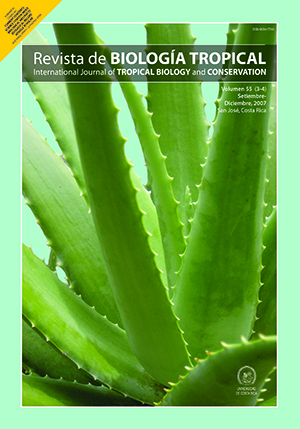Abstract
The structure community of cunaxids mites was studied at a tropical dry forest in the Chamela Biological Station, Jalisco, Mexico. Monthly samples of litter and soil were taken during one year (July 1991-May 1992), in two small watersheds. A total of 43 species was recorded. We studied their abundance, species frequency (F), rareness and relative abundance (Ar), density (ind m-2), species richness (S), Shannon’s diversity index (H’), and Pielou’s evenness index (J’). The species richness was similar in litter and soil (38 species), but species composition was different. The higher density was found in soil, with 5 074 ind m-2; litter density was 2 199 ind m-2. The subfamilies with the highest density in both biotopes were Coleoscirinae (H=1 127 ind m-2; S=2 235 ind m-2) and Cunaxiinae (H=887 ind m-2; S = 1 936 ind m-2). The genus Pulaeus had the most species, and all were new to science. Mean and variance indicate an aggregate distribution for these cunaxids. By permanency and relative abundance, the dominant species were: Cunaxa potchensis, Coleoscirus simplex, Armascirus harrisoni, Cunaxoides sp. nov. 1, Cunaxoides sp. nov. 2, Pulaeus sp. nov. 15 and Pulaeus sp. nov. 16. An significant effect of the month and the biotope were recorded on the diversity and composition of cunaxid communities. Most of the species presented a significant effect of the month (24 spp.) and biotope (23 spp.), and five species only had a significant effect of the watersheds. The highest similarity was in litter (75 %) and soil (74 %). The highest temporal variation in density, diversity and species richness was from April through June in litter, and from September through November in soil. The evenness was constant in both biotopes. In the dry period the soil presented higher values of density, while in the litter it was in the rainy season. The species with high soil density (FebruaryJune: dry season) in both watersheds, were: C. simple, C. potchensis, Cunaxa sp. nov. 1, Cunaxa sp. nov. 2, C. veracruzana, Dactyloscirus sp. nov. 2, A. harrisoni, Cunaxoides sp. nov. 1, Cunaxoides sp. nov. 2, P. pectinatus, Pulaeus sp. nov. 14, Pulaeus sp. nov. 15 and Pulaeus sp. nov. 16. They were the most representative species in the soil and litter of Chamela communities. The most abundant dry season species were C. potchensis in the soil and A. harrisoni in the litter
##plugins.facebook.comentarios##

This work is licensed under a Creative Commons Attribution 4.0 International License.
Copyright (c) 2007 Revista de Biología Tropical






